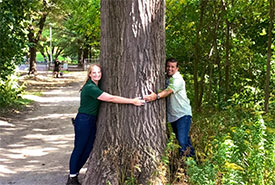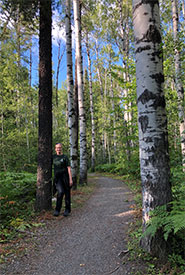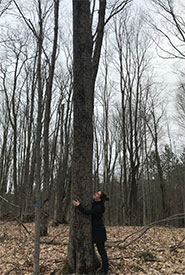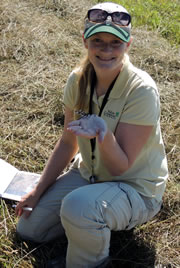Hugging trees

Anwar Knight and I hugging a black oak tree in High Park. (Photo courtesy of Anwar Knight)
I’m walking along a well-beaten dirt path in a favourite forest. The brilliant early fall sunshine streams through the leaves, which are gradually dimming from their vibrant summer green to hues of yellow, gold and the first tinges of red. A chickadee twitters from deep within the woods. Suddenly my eyes are drawn to a tree with shaggy black bark, just to my left. It’s a beautiful black cherry tree, recognizable by its bark that resembles burnt cornflakes. I smile at it and continue putting one foot on front of the other, the leaves making soft crunching noises under my hiking boots. Yet, my eyes are drawn back to the tree, and my footsteps slow until I’ve come to a stop in front of this being. And before I know it, almost unconsciously drawn into it, I have embraced this tree in a huge hug — an equally huge smile stretched across my face. We linger in our embrace for 10 seconds while I quietly thank it for all it does: provide food and shelter for birds, insects and mammals, convert carbon dioxide into the clean oxygen I’m breathing, and just be a part of this beautiful forest.
Related content

Having a moment with a beautiful jack pine in northern Ontario. (Photo by NCC)
I have always had a natural affinity for hugging trees. But only until recently, having dived into scientific literature about the physical and mental health benefits of being in nature, did I understand the deeper lure behind my embraces. For example, breathing in the unique chemicals (phytoncides) that plants produce to ward off disease actually boosts human immune systems too.
During a nature tour with the Nature Conservancy of Canada (NCC), where I had a group of Torontonians heartily hugging trees with me, someone asked me how to tell how old one of our leafy friends was. Some quick Googling showed us a tool that allows you to measure the age of a tree with a simple hug and some elementary school math.
How to calculate the age of a tree
Since the span of your outstretched arms is roughly equal to your height in inches, how far they wrap around a tree can be a stand-in for measuring circumference.
- You can estimate by checking if your fingers are touching. Do your hands overlap by six inches or do you need a friend to complete the hug?
- Divide the circumference by pi (roughly 3.14) yields the diameter.
- Multiply the diameter by a tree species’ growth factor, (or this resource), to determine the tree’s approximate age.

NCC staff Laura Vaughan hugs an endangered butternut tree at East Coulson Swamp. (Photo by NCC)
That day we hugged a red oak that was 140 years old, and later found a giant, beautiful American beech that measured 204 years! I’ve taken this hug show on the road too, hugging trees with people from all over Canada, and showing Canadians how to use this trick themselves in a demonstration in High Park with CTV’s Anwar Knight.
So next time you’re out for a walk in the woods and you can’t stop looking at that beautiful white birch or that stately sugar maple, I challenge you to stop, give it a squeeze and just try not to smile and feel great afterwards!
I love thinking about the long history of trees in areas conserved by groups like NCC, and how many hugs these trees might have received before mine. Particularly, I like thinking that because a space is protected for the long term, just how many more hugs they might receive during their long, productive lives.


